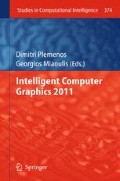Abstract
Declarative scene modelling is a very useful modelling technique which allows the user to create scenes by simply describing their wished properties and not the manner to construct them. In declarative modelling, solution filtering is a very important aspect due to the imprecise description of both the scene and the objects, as well as due to the subjective of humans regarding the content of a design is concerned. Currently, solution filtering is performed by the application of machine learning strategies or clustering methods in a collaborative or not framework. However, the main difficulty of these algorithms is that solution filtering is based on the usage of low-level attributes that describe either the scene or the object. This chapter addresses this difficulty by proposing a novel social oriented framework for solution reduction in a declarative modelling approach. In this case, we introduce semantic information in the organization of the users that participates in the filtering of the solutions. Algorithms derived from graph theory are presented with the aim to detect the most influent user with a social network (intra-social influence) or within different social groups (inter-social influence). Experimental results indicate the outperformance of the proposed social networking declarative modelling with respect to other methods.
Access this chapter
Tax calculation will be finalised at checkout
Purchases are for personal use only
Preview
Unable to display preview. Download preview PDF.
References
Dragonas, J., Makris, D., Lazaridis, A., Miaoulis, G., Plemenos, D.: Implementation of Collaborative Environment in MultiCAD Declarative Modelling System. In: International Conference on Computer Graphics and Artificial Intelligence (3IA 2005), Limoges, France, May 11-12 (2005)
Dragonas, J., Doulamis, N.: Web-based Collaborative System for Scene Modelling. In: Intelligent Scene Modelling Information Systems, pp. 121–151. Springer, Berlin (2009)
Rodriguez, K., Al-Ashaab, A.: A Review of Internet based Collaborative Product Development Systems. In: Proceedings of the International Conference on Concurrent Engineering: Research and Applications, Cranfield, UK (2002)
Shen, W.: Web-based Infrastructure for Collaborative Product Design: An Overview. In: 6th International Conference on Computer Supported Cooperative Work in Design, Hong Kong, pp. 239–244 (2000)
Kvan, T.: Collaborative design: What is it? Automation in Construction 9(4), 409–415 (2000)
Breslin, J., Decker, S.: The Future of Social Networks on the Internet- the need for semantics. IEEE Internet Computing, 86–90 (November-December 2007)
Ko, M.N., Cheek, G.P., Shehab, M., Sandhu, R.: Social Networks Connect Services. IEEE Computer Magazine, 37–43 (August 2010)
Douglis, F.: It’s All About the (Social) Network. IEEE Internet Computing, 4–6 (January-February 2010)
Plemenos, D., Miaoulis, G., Vassilas, N.: Machine Learning for a General Purpose Declarative Scene Modeller. In: International Conference on Computer Graphics and Vision (GraphiCon), Nizhny Novgorod (Russia), September 15-21 (2002)
Doulamis, A.: Dynamic Tracking Re-Adjustment: A Method for Automatic Tracking Recovery in Complex Visual Environments. Multimedia Tools and Applications 50(1), 49–73 (2010)
Doulamis, A.: Adaptable Neural Networks for Objects’ Tracking Re-initialization. In: Alippi, C., Polycarpou, M., Panayiotou, C., Ellinas, G. (eds.) ICANN 2009. LNCS, vol. 5769, pp. 715–724. Springer, Heidelberg (2009), doi:10.1007/978-3-642-04277-5_72
Bardis, G., Doulamis, N., Dragonas, J., Miaoulis, G., Plemenos, D.: A Parametric Mechanism for Preference Consensus in a Collaborative Declarative Design Environment. In: International Conference on Computer Graphics and Artificial Intelligent, Athens, Greece (2007)
Doulamis, N., Dragonas, J., Doulamis, A., Miaoulis, G., Plemenos, D.: Machine learning and pattern analysis methods for profiling in a declarative collaorative framework. In: Plemenos, D., Miaoulis, G. (eds.) Intelligent Computer Graphics 2009. Studies in Computational Intelligence, vol. 240, pp. 189–206. Springer, Heidelberg (2009)
Ng, Y., Jordan, M.I., Weiss, Y.: On spectral clustering: analysis and an algorithm. Neural Information Processing Systems 14 (2002)
Delias, P., Doulamis, A., Matsatsinis, N.: A Joint Optimization Algorithm For Dispatching Tasks In Agent-Based Workflow Management Systems. In: International Conference on Enterprise Information Systems (ICEIS), Barcelona, Spain (June 2008)
Rui, Y., Huang, T.S.: Optimizing Learning in Image Retrieval. In: Proc. of IEEE Int. Conf. on Computer Vision and Pattern Recognition (June 2000)
Haykin, S.: Neural Networks: A Comprehensive Foundation, 2nd edn. Prentice Hall Press, Englewood Cliffs (1998)
Brandes, U.: Social network analysis and visualization. IEEE Signal Processing Magazine 25(6), 147–151 (2008)
Dragonas, J., Doulamis, N.: Web-based collaborative system for scene modelling. In: Miaoulis, G., Plemenos, D. (eds.) Intel. Scene. Mod. Information Systems. SCI, vol. 181, pp. 121–151. Springer, Heidelberg (2009)
Doulamis, N., Bardis, G., Dragonas, J., Miaoulis, G.: Optimal recursive designers’ profile estimation in collaborative declarative environment. In: International Conference on Tools with Artificial Intelligence, ICTAI 2, art. no. 4410416, pp. 424–427 (2007)
Harold, A., Jay Sussman, G., Sussman, J.: Structure and Interpretation of Computer Programs, 2nd edn. MIT Press, Cambridge (1996)
Kilker, J.: Conflict on collaborative design teams: understanding the role of social identities. IEEE Technology and Society Magazine 18(3), 12–21 (1999)
Gummadi, G.P., Dunn, R.J., Saroiu, S., Gribble, S.D., Levy, H.M., Zahorjan, J.: Measurement, modeling and analysis of a peer-to-peer file-sharing workload. In: Proc. 19th ACM Symp. Operating Systems Principles (SOSP-19), pp. 314–329 (October 2003)
Liang, J., Kumar, R., Xi, Y., Ross, K.W.: Pollution in P2P file sharing systems. IEEE InfoCom 2, 1174–1185 (2005)
Vicky Zhao, H., Sabrina Lin, W., Ray Liu, K.J.: Behavior Modeling and Forensics for Multimedia Social Networks. IEEE Signal Processing Magazine, 118–139 (January 2009)
Watts, D.J., Strogatz, S.H.: Collective dynamics of small-world networks. Nature 393(6684), 440–442 (1998)
Barabási, A.L., Albert, R.: Emergence of scaling in random networks. Science 286(5439), 509–512 (1999)
Barnes, J.A.: Class and committees in a Norwegian Island parish. Human Relations 7(1), 39–58 (1954)
Freeman, L.C. (ed.): Social Network Analysis I–IV. Sage, Newbury Park (2008)
Pentland, A.S.: Social Signal Processing, pp. 108–111 (July 2007)
Author information
Authors and Affiliations
Editor information
Editors and Affiliations
Rights and permissions
Copyright information
© 2012 Springer-Verlag Berlin Heidelberg
About this chapter
Cite this chapter
Doulamis, N., Dragonas, J., Pliota, D., Miaoulis, G., Plemenos, D. (2012). Objects Description Exploiting User’s Sociality. In: Plemenos, D., Miaoulis, G. (eds) Intelligent Computer Graphics 2011. Studies in Computational Intelligence, vol 374. Springer, Berlin, Heidelberg. https://doi.org/10.1007/978-3-642-22907-7_3
Download citation
DOI: https://doi.org/10.1007/978-3-642-22907-7_3
Publisher Name: Springer, Berlin, Heidelberg
Print ISBN: 978-3-642-22906-0
Online ISBN: 978-3-642-22907-7
eBook Packages: EngineeringEngineering (R0)

